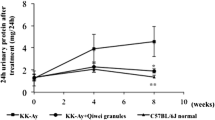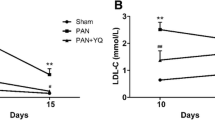Abstract
Objective
To investigate the effects of Huaiqihuang Granules (槐杞黄颗粒, HQH), a mixture of Chinese herbs including Trametes robiniophila Murr, Fructus Lycii and Polygonatum sibiricum, on adriamycininduced nephropathy (ADRN) in rats and its underlying mechanisms.
Methods
Rats with ADRN were divided into four groups: the sham group, the model group (distilled water), the low-dose HQH-treated (2 g/kg) group, and the high-dose HQH-treated (4 g/kg) group. Body weight and 24-h urinary protein (Upro) were checked every week. After 5-week intervention, at the end of the study, the rats were sacrificed and blood samples were collected for examination of biochemical parameters, including glomerular morphological makers, podocyte shape, cellular apoptosis, expressions of nephrin, inflammatory and apoptosis markers.
Results
HQH ameliorated the rat’s general status, proteinuria, renal morphological appearance and glomerulosclerosis. The decreased expression of nephrin in ADRN rats was increased by HQH, as well as the impaired podocyte foot process fusion. Cytosolic levels of p65 and inhibitor of nuclear factor κBα (IκBα) were decreased in ADRN rats, and recovered by the treatment of HQH. Consistently, the induced expression of tumor necrosis factor α (TNF-α), phosphorylated nuclear factor κB p65 (p-NFκB p65) and IκBα in ADRN were markedly suppressed by HQH. In addition, induction of Bax, cleaved caspase-3 and cytochrome C in ADRN rats were suppressed by HQH, indicating the amelioration of apoptosis.
Conclusion
HQH could ameliorate renal impairments in ADRN rats by increasing nephrin expression, inhibiting NF-κB signaling pathway via the down-regulation of p-NF-κB p65 and p-IκBα, and suppression of glomerular and tubular apoptosis.
Similar content being viewed by others
References
Zhang L, Wang F, Wang L, Wang W, Liu B, Liu J, et al. Prevalence of chronic kidney disease in China: a crosssectional survey. Lancet 2012;379:815–822.
Shankland SJ. The podocyte’s response to injury: role in proteinuria and glomerulosclerosis. Kidney Int 2006;69:2131–2147.
Ristola M, Lehtonen S. Functions of the podocyte proteins nephrin and Neph3 and the transcriptional regulation of their genes. Clin Sci (Lond) 2014;126:315–328.
Hauser PV, Collino F, Bussolati B, Camussi G. Nephrin, endothelial injury. Curr Opin Nephrol Hypertens 2009;18:3–8.
Takano Y, Yamauchi K, Hayakawa K, Hiramatsu N, Kasai A, Okamura M, et al. Transcriptional suppression of nephrin in podocytes by macrophages: roles of inflammatory cytokines and involvement of the PI3K/Akt pathway. Febs Lett 2007;581:421–426.
Sun W, He Y, Yu J, Lin Y, Wang Y, Gao X, et al. Effect of yiqiyangyin recipe on heparanase and nephrin in rats with adriamycin-induced nephropathy. J Tradit Chin Med (Chin) 2013;33:334–42.
Guijarro C, Egido J. Transcription factor-kappa B (NF-kappa B) and renal disease. Kidney Int 2001;59:415–24.
Rangan G, Wang Y, Harris D. NF-kappa B signalling in chronic kidney disease. Front Biosci (Landmark ed) 2009;14:3496–3522.
Sanz AB, Sanchez-Niño MD, Ramos AM, Moreno JA, Santamaria B, Ruiz-Ortega M, et al. NF-κB in renal inflammation. J Am Soc Nephrol 2010;21:1254–1262.
Tacar O, Sriamornsak P, Dass CR. Doxorubicin: an update on anticancer molecular action, toxicity and novel drug delivery systems. J Pharm Pharmacol 2013;65:157–170.
Leung LK, Wang TT. Differential effects of chemotherapeutic agents on the Bcl-2/Bax apoptosis pathway in human breast cancer cell line MCF-7. Breast Cancer Res Treat 1999;55:73–83.
Zhang AQ, Fu SL, Ji LL. Effect of Huai Qi Huang on immunofunction of children with recurrent respiratory infection. J Harbin Med Univ (Chin) 2011;45:269–271.
Zhang B, Ni N, Wu YB. Effect of Huaiqihuang Granules on serum TNF-a, IL-18 and IL-10 in children with primary nephrotic syndrome. Chin J Pract Pediatr (Chin) 2010;25:33–36.
Li LT, Shi MY, Wei SY, Li T, Li B. Huai Qi Huang ameliorates proteinuria and hematuria in mild IgA nephropathy patients: a prospective randomized controlled study. J Formos Med Assoc 2013;112:766–772.
Zhu C, Huang S, Ding G, Yuan Y, Chen Q, Pan X, et al. Protective effects of Huangqihuai Granules on adriamycin nephrosis in rats. Pediatr Nephrol 2011;26:905–913.
Tu Y, Sun W, Wan YG, Che XY, Pu HP, Yin XJ, et al. Huangkui Capsule, an extract from Abelmoschus manihot (L.) medic, ameliorates adriamycin-induced renal inflammation and glomerular injury via inhibiting p38MAPK signaling pathway activity in rats. J Ethnopharmacol 2013;147:311–320.
Lu HY, Zhang QL, Jiang XY, Chen LZ, Mo Y, Chen SM. Effects of Huaiqihuang on proteinuria and nephrin, podocin in rats with IgA nephropathy. Chin J Obs/Gyne Pediatr (Electr ed) 2009;05:458–465.
Wang Z, Chen Y, Luo J, Zhou JH. Clinical observation on immunity nephritis model mouse treated by Huaiqihuang and related analysis of mechanism. Chin J Integr Tradit West Nephrol (Chin) 2011;11:974–978.
Wan YG, Che XY, Sun W, Huang YR, Meng XJ, Chen HL, et al. Low-dose of multi-glycoside of Tripterygium wilfordii Hook. f., a natural regulator of TGF-beta1/Smad signaling activity improves adriamycin-induced glomerulosclerosis in vivo. J Ethnopharmacol 2014;151:1079–1089.
Lydia A, Asanuma K, Nonaka K, Takagi M, Jeong KH, Kodama F, et al. Effects of 22-oxa-calcitriol on podocyte injury in adriamycin-induced nephrosis. Am J Nephrol 2012;35:58–68.
Legrand-Poels S, Schoonbroodt S, Piette J. Regulation of interleukin-6 gene expression by pro-inflammatory cytokines in a colon cancer cell line. Biochem J 2000;349 Pt 3:765–773.
Zandi-Nejad K, Eddy AA, Glassock RJ, Brenner BM. Why is proteinuria an ominous biomarker of progressive kidney disease? Kidney Int Suppl 2004:S76-S89.
Kerjaschki D. Caught flat-footed: podocyte damage and the molecular bases of focal glomerulosclerosis. J Clin Invest 2001;108:1583–1587.
Zhang P, Zhang JJ, Su J, Qi XM, Wu YG, Shen JJ. Effect of total glucosides of paeony on the expression of nephrin in the kidneys from diabetic rats. Am J Chin Med 2009;37:295–307.
Sauter KA, Wood LJ, Wong J, Iordanov M, Magun BE. Doxorubicin and daunorubicin induce processing and release of interleukin-1 beta through activation of the NLRP3 inflammasome. Cancer Biol Ther 2011;11:1008–1016.
Doublier S, Ruotsalainen V, Salvidio G, Lupia E, Biancone L, Conaldi PG, et al. Nephrin redistribution on podocytes is a potential mechanism for proteinuria in patients with primary acquired nephrotic syndrome. Am J Pathol 2001;158:1723–1731.
Zhu W, Lu Q, Chen HW, Feng J, Wan L, Zhou DX. Protective effect of sodium tanshinone II A sulfonate on injury of small intestine in rats with sepsis and its mechanism. Chin J Integr Med 2012;18:496–501.
Hussain S, Romio L, Saleem M, Mathieson P, Serrano M, Moscat J, et al. Nephrin deficiency activates NF-kappaB and promotes glomerular injury. J Am Soc Nephrol 2009;20:1733–1743.
Kriz W. Podocyte is the major culprit accounting for the progression of chronic renal disease. Microsc Res Tech 2002;57:189–195.
Mundel P, Shankland SJ. Podocyte biology and response to injury. J Am Soc Nephrol 2002;13:3005–3015.
Wharram BL, Goyal M, Wiggins JE, Sanden SK, Hussain S, Filipiak WE, et al. Podocyte depletion causes glomerulosclerosis: diphtheria toxin-induced podocyte depletion in rats expressing human diphtheria toxin receptor transgene. J Am Soc Nephrol 2005;16:2941–2952.
Dutta J, Fan Y, Gupta N, Fan G, Gelinas C. Current insights into the regulation of programmed cell death by NF-kappa B. Oncogene 2006;25:6800–6816.
Jiang XJ, Huang KK, Yang M, Qiao L, Wang Q, Ye JY, et al. Synergistic effect of panobinostat and bortezomib on chemoresistant acute myelogenous leukemia cells via AKT and NF-kappa B pathways. Cancer Lett 2012;326:135–142.
Author information
Authors and Affiliations
Corresponding author
Additional information
Supported by the National Natural Science Foundation of China (No. 81373607), the Priority Academic Program Development of Jiangsu Higher Education Institutions, and the Science and Technology Funding for Life and Health Care of Jiangsu Province (No. BL2012032)
Rights and permissions
About this article
Cite this article
Liu, H., Sun, W., Gu, Lb. et al. Huaiqihuang Granules (槐杞黄颗粒) reduce proteinuria by enhancing nephrin expression and regulating necrosis factor κB signaling pathway in adriamycin-induced nephropathy. Chin. J. Integr. Med. 23, 279–287 (2017). https://doi.org/10.1007/s11655-015-2293-0
Received:
Published:
Issue Date:
DOI: https://doi.org/10.1007/s11655-015-2293-0




